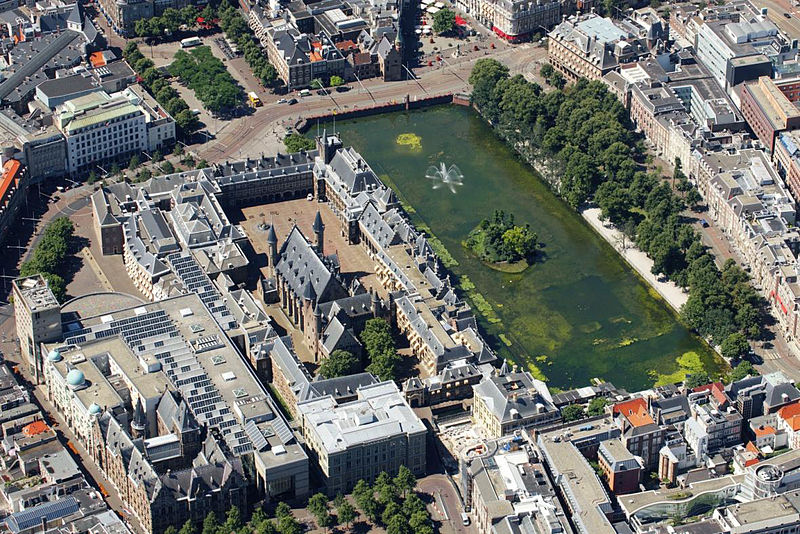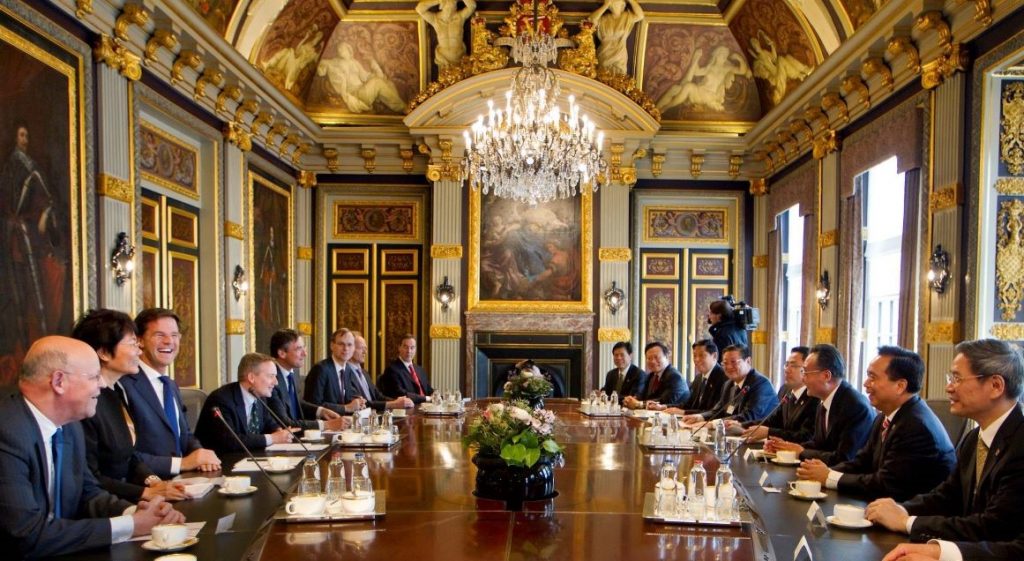Binnenhof: Trêveszaal Posted by Sten on Jun 15, 2020 in Dutch Language
The Binnenhof (Inner Court) is the center of the Dutch overheid (government). Located in the heart of Den Haag (The Hague), it oozes Dutch geschiedenis (history) and verhalen (stories). In this series, we’ll go building by building and explore what each is all about. Today, let’s check out the Trêveszaal!
For more posts in the Binnenhof series, click here.
What is the Trêveszaal?
The Trêveszaal (Trêves Hall) is located next to the Torentje, at the bottom right on the picture above, looking out onto the Hofvijver (Court Pond).
The hall was built in 1696. But it was not built from the ground up, but rather renovated the rooms that came before it. The building itself probably goes back to the early days of the Binnenhof. In 1588, at the beginning of the Republiek der Zeven Verenigde Nederlanden (Republic of the Seven United Netherlands), the Staten-Generaal began using these halls as their vergaderzalen (meeting halls). This was at a time when the Dutch were still in war with the Spanish, who claimed ownership over the Dutch lands. The Tachtigjarige Oorlog (Eighty Years’ War) would only end 60 years later in 1648, with the Peace of Westphalia. Those warring times were interrupted only by a brief period of relative peace – the Twaalfjarig Bestand (Twelve Years’ Truce), from 1609-1621. This Trêve, the French word for truce, was negotiated in 1608 in a hall that we now know as the Trêveszaal.
Like the early days of the United States, the early days of the Dutch Republic were function over form. It didn’t matter that the halls didn’t look mighty. While this worked very well for its early days, its shortcomings became clear after a few decades. In 1620, a foreigner called the Trêveszaal a “povero luogo”, a “shabby place”. And so there was a growing demand for more pronk (splendour), which came as the Staten-Generaal gained in influence. Finally, in 1696, the Staten-Generaal decided to verbouwen (remodel) two of the halls in which they met. One was to be a “zaal waar gezanten op gepaste wijze ontvangen konden worden” (hall where envoys could be welcomed in a proper manner). And that’s how the Trêveszaal became the fancy, Louis XIV-style space as we know it today.
The hall has not undergone many changes since then. During renovations, it has mostly been spared. In 2002, a few changes were made, updates if you will. New kroonluchters (chandeliers) were installed, a new vergadertafel (meeting table) was placed, and the tapijt (carpet) and gordijnen (curtains) were renewed.
Why does the Trêveszaal matter?
From 1815 to 1849, the Trêveszaal was used for vergaderingen of the Eerste Kamer (First Chamber, Higher Chamber of Dutch Parliament). These days, the hall is part of the Ministerie van Algemene Zaken (Ministry for General Affairs), and is used for the wekelijkse vergadering van de ministerraad (weekly meeting of the council of ministers). When exactly they started doing this in the Trêveszaal is not entirely clear, but for sure at some point after the Second World War.
The hall is also still used for its intended, original purpose: To welcome staatshoofden (heads of state) and other high-ranking foreign officials. Meetings with foreign delegations can also take place in this prestigious room.

Build vocabulary, practice pronunciation, and more with Transparent Language Online. Available anytime, anywhere, on any device.






